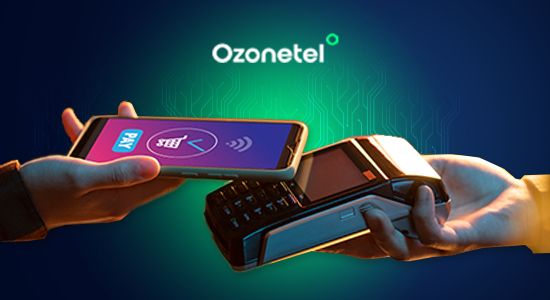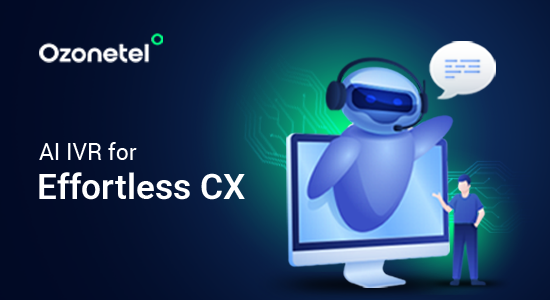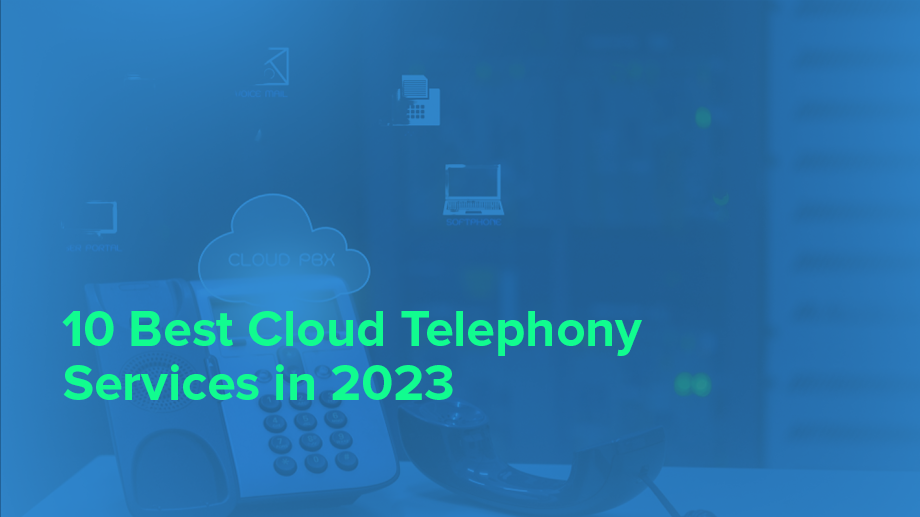- Resources
- How Voice AI Agent Can Help Tackle High Volume at Contact Center
How Voice AI Agent Can Help Tackle High Volume at Contact Center

Contact centers often struggle to balance speed and service quality when call volumes spike. Customers grow impatient waiting in queues, and agents feel pressured to rush through interactions. As a result, service suffers, and customers leave frustrated.
Voice AI Agents help solve this by handling multiple calls at once, resolving routine inquiries, and routing complex issues to human agents. This means faster response times, reduced agent stress, and a smoother experience for everyone.
Keep reading to know more!
In this article, we will explore:
- 1.The Challenge of High Call Volumes
- 2. How Voice AI Agent Can Solve This
- 3.Difference Between Voice Blaster and Voice Bots
- 4. How Do Voice Bots for the Contact Center Work?
- 5.How Voice AI Agents Help Tackle High Call Volumes
- 6.Business Application of Voice AI Agent
- 7.Ozonetel Use Cases
- 8.To Conclude
What Is Customer Obsession?
Customer obsession is about placing your customers at the core of every decision you make. It goes beyond simply satisfying their needs—it’s about actively working to improve their experience at every touchpoint, anticipating what they want, and addressing their concerns before they even raise them.
The Challenge of High Call Volumes
High call volumes put immense pressure on contact centers, leading to:
- Long wait times: Customers often spend minutes or even hours in queues, increasing frustration.
- Overworked agents: Human agents struggle to handle the influx, leading to stress and burnout.
- Missed calls and dropped connections: Some customers hang up before reaching an agent, resulting in lost opportunities.
- Inconsistent service quality: As call loads increase, response times and service quality suffer.
- Limited after-hours support: Businesses that rely on human agents can’t provide 24/7 service, impacting customer experience.
How Voice AI Agent Can Solve This
A Voice AI Agent helps manage high call volumes efficiently by automating responses, optimizing workflows, and improving customer interactions. Here’s how:
- Instant Response Without Queues: Voice AI Agents can handle unlimited calls simultaneously, eliminating wait times. Customers receive immediate responses instead of waiting in a queue.
- Handling Routine Queries Automatically: AI can answer frequently asked questions (FAQs) related to:
- Order status
- Billing and payments
- Appointment scheduling
- Account resets
This frees up human agents to focus on complex cases that require critical thinking and empathy.
- Intelligent Call Routing for Faster Resolutions: AI identifies the nature of a call and routes it to the right department if human assistance is needed. It also collects key details before transferring, ensuring a smoother conversation when a human takes over.
- Prioritizing Urgent Cases: AI recognizes high-priority issues, such as fraud alerts or service outages, and escalates them immediately. This ensures that critical matters get resolved faster while standard inquiries continue to be handled efficiently.
- 24/7 Support Without Additional Costs: Voice AI operates around the clock, providing customer assistance even after business hours. This eliminates the need to hire extra agents for night shifts or holiday coverage.
- Reducing Agent Workload and Burnout: By handling repetitive tasks, AI reduces the stress on human agents. They can focus on meaningful customer interactions, leading to better service and higher job satisfaction.
What Is Voice AI Agent?
A voice AI agent is an advanced system that uses artificial intelligence (AI) and natural language processing (NLP) to interact with users through voice. It can understand, interpret, and respond to spoken commands, making conversations feel more natural and efficient.
Difference Between Voice Blaster and Voice Bots
Both voice blasters and voice bots use AI-driven voice technology, but they serve different purposes. A voice blaster is designed for mass outbound calls, helping businesses reach a large audience efficiently. On the other hand, a voice bot enables real-time, interactive conversations, handling inbound and outbound queries without human intervention. Here’s how they differ:
| Feature | Voice Blaster | Voice Bot |
|---|---|---|
| Purpose | Sends pre-recorded or AI-generated voice messages to multiple users at once. | Engages in two-way conversations, understanding and responding to user queries. |
| Interaction Type | One-way communication (outbound calls only). | Interactive, allowing real-time conversations. |
| Use Case | Ideal for promotions, reminders, surveys, and announcements. | Suitable for customer support, appointment scheduling, and automated query resolution. |
| AI Involvement | Uses AI to personalize messages but does not process responses. | Uses AI and Natural Language Processing (NLP) to understand and respond to users. |
| Response Handling | No real-time response; users receive a message without interacting. | Can handle queries, provide relevant information, and assist users dynamically. |
| Scalability | Can reach thousands of users simultaneously with minimal effort. | Scales based on system capacity and user demand, handling multiple queries efficiently. |
How Do Voice Bots for the Contact Center Work?
A voice bot understands, processes, and responds to queries without human intervention, reducing wait times and improving call handling efficiency. Here’s a step-by-step breakdown of how it works:
- Speech Recognition: The voice bot starts by converting spoken words into text using Automatic Speech Recognition (ASR) technology. This allows it to understand customer queries accurately, even if they are spoken in different accents or speeds.
- Natural Language Processing (NLP): Once the speech is converted to text, Natural Language Processing (NLP) analyzes the intent behind the words. It identifies key information such as the issue type, customer name, and urgency, making responses more relevant.
- Intelligent Call Routing: If the bot cannot resolve a query, it routes the call to the right human agent. It transfers the context of the conversation, so customers don’t have to repeat themselves.
- Automated Responses and Actions: The bot responds based on pre-trained AI models and integrated databases. It can provide answers to FAQs, process payments, reset passwords, and schedule appointments, reducing the need for human agents.
- Continuous Learning and Improvement: With Machine Learning (ML), the bot improves over time by analyzing past interactions. It learns new phrases, customer preferences, and better ways to respond to complex queries.
- Integration with Contact Center Systems: The voice bot connects with Customer Relationship Management (CRM) and other support tools to access customer history, personalize responses, and update records in real-time.
How Voice AI Agents Help Tackle High Call Volumes
Managing high call volumes in a contact center can be challenging, leading to long wait times, frustrated customers, and overwhelmed agents. A voice AI agent helps streamline operations by handling routine queries, prioritizing urgent cases, and optimizing resource allocation. Here’s how it improves call handling efficiency:
1. Automating Routine Queries
Voice AI Agents can handle frequently asked questions (FAQs) without human intervention. Customers can instantly get answers about:
- Order status and tracking updates
- Billing and payment details
- Appointment scheduling
- Account recovery and password resets
By offloading these repetitive queries to AI, human agents can focus on more complex cases, reducing overall call congestion.
2. Reducing Wait Times with Instant Responses
Unlike human agents, Voice AI Agents can handle multiple calls simultaneously. They don’t get overwhelmed, ensuring that every caller gets an immediate response. This significantly reduces wait times, improving customer satisfaction.
For instance, if 100 customers call at the same time, the AI can engage with all of them instead of making them wait in a queue.
3. Intelligent Call Routing
Voice AI Agents don’t just answer calls—they also identify the intent behind a query and route it to the right department if human assistance is needed. They collect relevant details before transferring the call, ensuring a seamless handover.
For example, if a customer has a technical issue, the AI gathers information about the problem and connects them directly to a technical support agent, saving time.
4. Prioritizing Urgent Cases
AI can differentiate between standard inquiries and urgent issues. If a customer reports a lost credit card or a system outage, the AI escalates the case immediately instead of putting them through a standard queue.
This prioritization helps critical cases get resolved faster, preventing escalations and dissatisfaction.
5. 24/7 Availability for Continuous Support
Unlike human agents, Voice AI operates around the clock, ensuring support even after business hours. Customers can call anytime for assistance, whether it’s a billing inquiry, a service request, or a troubleshooting issue.
This is especially useful for global businesses that cater to customers across different time zones.
6. Reducing Agent Workload and Burnout
High call volumes can overwhelm human agents, leading to stress and decreased productivity. Voice AI Agents handle repetitive tasks, allowing agents to focus on more engaging and complex customer interactions.
With a reduced workload, human agents can provide better service, leading to higher job satisfaction and lower attrition rates.
7. Continuous Learning for Better Accuracy
Voice AI Agents improve over time using Machine Learning (ML). They analyze past interactions, learn from customer feedback, and refine responses to become more efficient.
For example, if customers frequently use a specific phrase to describe a problem, the AI adapts to recognize it more accurately, reducing misunderstandings.
Business Application of Voice AI Agent
Voice AI agents offer a scalable solution by automating routine interactions, reducing wait times, and improving engagement across various touchpoints. Here’s how businesses across different sectors are using Voice AI to streamline operations and drive efficiency:
OTP via Voice
Voice AI Agents can deliver One-Time Passwords (OTPs) via automated voice calls, providing an additional layer of security for user authentication. This is particularly useful in:
- Banking and Finance: Secure logins, fund transfers, and high-value transactions.
- Ecommerce & Retail: Account verification, password resets, and checkout authentication.
- Telecom: SIM activation, number porting, and secure login attempts.
Unlike SMS OTPs, voice-based authentication reduces failures due to network issues and provides accessibility for users who may not receive text messages.
Cash-on-Delivery Confirmation via Voice
Voice AI Agents can automatically call customers to confirm cash-on-delivery (COD) orders before dispatch. This helps in:
- Reducing Order Returns: Customers confirm their availability, reducing refusals and operational costs.
- Preventing Fake Orders: AI Agents can verify the legitimacy of the order by asking a few validation questions.
- Improving Logistics Efficiency: Only confirmed orders are processed, ensuring a smoother supply chain.
Payment Reminders
Late payments can affect a business’s cash flow. Voice AI Agents help by:
- Sending automated reminders for loan EMIs, credit card bills, and utility payments before due dates.
- Offering real-time payment assistance by guiding customers to complete transactions via IVR (Interactive Voice Response).
- Providing multilingual support to reach a broader customer base.
- Reducing reliance on manual follow-ups, freeing up human agents for complex cases.
Call Notifications
Businesses use Voice AI Agents to deliver important updates and alerts, reducing the burden on customer support teams. These notifications include:
- Order and Delivery Updates: Real-time shipping status, delays, or delivery confirmations.
- Service Disruptions: Power outages, flight reschedules, internet downtime, etc.
- Policy and Account Changes: Banks and insurance firms use AI to notify customers of KYC renewals, account security alerts, or policy updates.
- Appointment Reminders: Clinics, hospitals, and salons send automated reminders to minimize no-shows.
Lead Qualification
Voice AI Agents can handle initial lead interactions, qualify potential customers, and route them to sales teams. The AI:
- Engages Prospects in Real Time: Calls potential leads, asks relevant questions and assesses their interest.
- Categorizes Leads Based on Intent: AI can score leads as hot, warm, or cold based on their responses.
- Schedules Follow-ups: High-priority leads are transferred to human sales representatives for closing deals.
This is especially useful for real estate, financial services, and high-ticket sales businesses that rely on efficient lead management.
Feedback Collection
Voice AI Agents automate post-interaction surveys to measure customer satisfaction. Businesses use them to:
- Capture Customer Experience Insights: AI can ask structured questions after a service call or purchase.
- Analyze Sentiment: AI can detect customer sentiment through tone and response patterns.
- Improve Products & Services: Feedback data helps businesses refine their offerings and address customer concerns.
Appointment Scheduling
Voice AI Agents automate appointment bookings without human intervention. Customers can:
- Book, Reschedule, or Cancel Appointments: AI interacts with users in real-time to update schedules.
- Receive Confirmation & Reminders: Reduces missed appointments in healthcare, legal, and professional service sectors.
- Sync with CRM Systems: AI updates booking systems instantly to avoid double bookings.
Voice AI Agent in Healthcare
Healthcare providers use Voice AI Agents for:
- Appointment Management: Automating reminders, confirmations, and cancellations.
- Prescription & Follow-up Calls: Reminding patients about medication and post-treatment care.
- Health Survey Collection: Gathering patient feedback after consultations or procedures.
- Emergency Alerts: Notifying patients about urgent healthcare updates.
Voice AI Agent in BFSI
Voice AI Agents streamline financial interactions through:
- Automated KYC Verification: Helping banks verify customer details over a call.
- Fraud Prevention Alerts: Instant notifications of suspicious transactions.
- Loan Application Assistance: Guiding customers through eligibility checks and application status updates.
- Credit Score & Policy Renewals: AI can remind customers to check their scores or renew policies.
Voice AI Agent in EdTech
Education technology platforms use Voice AI Agents to:
- Assist with Student Onboarding: AI can answer admission queries and enrollment steps.
- Send Class & Exam Reminders: Automated calls notify students of schedules.
- Collect Feedback from Students & Parents: Gathering course feedback to improve learning experiences.
- Offer Multilingual Support: Making learning accessible to students across different regions.
Voice AI Agent in Ecommerce
Ecommerce businesses integrate Voice AI for:
- COD Order Confirmation: Verifying customer intent before dispatching COD orders.
- Order Tracking & Delivery Updates: Providing real-time shipping status.
- Returns & Refunds Assistance: Guiding customers through the return process.
- Upselling & Cross-selling Opportunities: AI can recommend related products based on purchase history.
Ozonetel Use Cases
Ozonetel’s cloud-based contact center solutions help businesses automate processes, improve efficiency, and enhance customer engagement. Here’s how leading brands have used Ozonetel to achieve measurable results:
Reduce Abandonment Rates
In stockbroking, call volumes fluctuate heavily based on market trends. AngelOne’s previous call center solutions failed to handle peak loads, leading to system crashes and high abandonment rates.
Solution:
Ozonetel provided a robust, scalable cloud contact center capable of handling 40,000+ calls daily and 1,000+ concurrent calls without downtime. The solution included:
- Intelligent IVR (Interactive Voice Response) to automate customer interactions.
- Callbacks & proactive notifications to reduce customer frustration.
- Remote agent support, enabling work-from-home teams to operate efficiently.
Results:
- 58% reduction in call abandonment rates due to lower wait times.
- 35-40% of calls automated, reducing agent workload.
- 25% faster handling times and 40% lower agent attrition, improving service quality.
Read the entire case study here!
Automate Loan Reminders
Mahindra Finance needed an automated loan repayment reminder system that could scale across 350+ branches, especially in Tier 2 and Tier 3 cities. The existing manual process was time-consuming and inefficient.
Solution:
Ozonetel deployed a Voice AI-based reminder system, automating 5 million personalized loan repayment reminders monthly. This eliminated manual follow-ups and enabled:
- 50% faster processing compared to manual calls.
- Automated reach-outs to 100,000+ loan applicants and guarantors monthly.
- 95% reduction in turnaround time (TAT), cutting the process from 2 days to just 2 hours.
Results:
- Higher repayment compliance with fewer missed payments.
- Increased efficiency in loan assessment and verification.
- Improved customer experience with timely, automated reminders.
Boost Customer Engagement
Muthoot Fincorp wanted to promote its Indivara gold jewelry collection to its 5 million customers while also maintaining customer engagement for its gold loan business. However, limited branch resources made personalized interactions difficult.
Solution:
Ozonetel’s Voice Bot technology automated customer outreach and payment reminders, ensuring:
- 8,700+ automated collection calls daily, improving payment efficiency.
- Higher engagement for gold jewelry promotions through automated follow-ups.
- Reallocation of human agents to higher-value tasks, improving workforce efficiency.
Results:
- 5-8% increase in installment collections, reducing payment delays.
- More efficient customer communication, with automated interactions preferred for reminders.
- Scalable engagement strategy without increasing operational costs.
To Conclude
When call volumes spike, long wait times and agent fatigue can impact customer experience. Voice AI agents can step in to handle repetitive queries, deflect unnecessary calls, and seamlessly transfer complex cases to human agents—all while maintaining a natural, human-like interaction.
With Ozonetel CX Hub, you can:
- Enable AI-driven call routing to connect customers to the right agents instantly.
- Deploy conversational AI bots that understand customer queries and provide instant solutions.
- Leverage real-time sentiment analysis to enhance agent performance and customer interactions.
Experience how Ozonetel can streamline customer interactions while keeping service levels high.
Conclusion: How Ozonetel Can Help
Building a customer-first culture requires the right tools to support seamless communication, real-time insights, and personalized interactions. Ozonetel’s cloud communication solutions help businesses streamline customer interactions, improve response times, and enhance overall customer satisfaction.
With features like:
- Omnichannel communication to connect with customers across voice, chat, email, and social platforms.
- AI-driven analytics to track customer sentiment and improve service quality.
- Intelligent call routing to reduce wait times and connect customers with the right agents faster.
- Automated follow-ups and self-service options to ensure customer concerns are addressed promptly.
Discover How Voice AI Agent Enhances Contact Center Efficiency
Frequently Asked Questions
Adopting a customer-first approach requires structural and cultural shifts within a company. Some common challenges include:
- Siloed Departments: Lack of coordination between sales, support, and product teams can lead to inconsistent customer experiences.
- Slow Response Time: If customer queries are not addressed quickly, satisfaction drops.
- Inflexible Policies: Rigid return, refund, or service policies may frustrate customers.
- Lack of Personalization: Treating all customers the same can reduce engagement.
- Measuring Customer Sentiment: Many businesses don’t track customer satisfaction effectively.
To assess how well your company prioritizes customers, track these key metrics:
- Net Promoter Score (NPS): Measures how likely customers are to recommend your business.
- Customer Satisfaction Score (CSAT): Captures immediate satisfaction levels after interactions.
- Customer Retention Rate: Indicates how well you keep existing customers.
- Customer Churn Rate: Tracks the percentage of customers who stop using your services.
- First Response Time (FRT): Measures how quickly customer queries are addressed.
- Customer Lifetime Value (CLV): Shows the total revenue a business can expect from a single customer over time.
Ozonetel is reshaping customer experience by integrating cloud-based communication solutions that offer features such as:
- Omnichannel Support: Unifying voice, chat, email, and social media interactions for seamless customer service.
- AI-Powered Analytics: Using AI to track customer sentiment and predict behavior for proactive service.
- Automation & IVR (Interactive Voice Response): Reducing wait times and improving first-call resolution with intelligent call routing.
- Remote & Hybrid Support Solutions: Allowing customer service teams to operate efficiently from anywhere.







